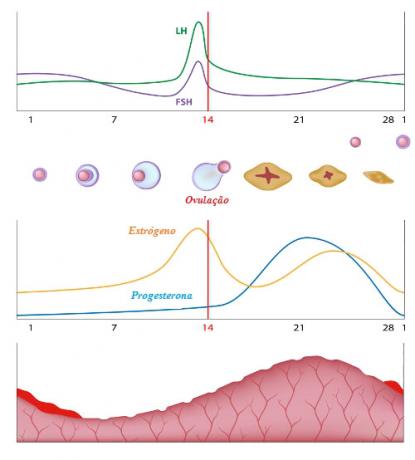Everyone knows that women, from 12 to 15 years old, in most cases, monthly have a bleeding called menstruation. However, few people know or understand the process that leads to such bleeding. We will clarify what is the menstrual cycle and the hormones involved in this process.
→ What is the menstrual cycle?
The menstrual cycle can be defined as a normal physiological process that occurs cyclically in women of childbearing age. This process is controlled by hormones and causes changes in the endometrium, which, during the process, proliferates and then is eliminated. Usually a menstrual cycle lasts around 28 days, but there are women with cycles shorter or longer than this period.
→ Phases of the menstrual cycle
During the menstrual cycle, the endometrium undergoes changes caused by the action of the hormones estrogen and progesterone. Despite being a continuous process, it is possible to notice the presence of three phases: menstrual phase, proliferative phase and secretory phase.

Note the simplified scheme of the menstrual cycle
Menstrual phase: During this period, there is the so-called menstruation, a process that marks the beginning of the cycle. This phase only occurs if there is no fertilization of the secondary oocyte released in the ovulation process. The stage is marked by the end of the corpus luteum functioning and by a sudden drop in the levels of the hormones estrogen and progesterone, which results in the destruction of the functional layer of the endometrium.
The period of menstruation varies greatly from one woman to another, however it is common to take three days or more. During menstruation, blood is released, due to ruptured arteries present in the area, and fragments of the endometrium.
Proliferative phase: Soon after menstruation, it is noticed that the uterine mucosa is relatively reduced. Despite the desquamation, it is possible to notice the permanence of the basal layer, which does not scale and allows the renewal of the lost endometrium.
In the proliferative phase, which lasts an average of 10 days, there is cell proliferation of the endometrium, which at this stage is reconstituted. The glands in this region also prepare for the start of their secretory phase.
The entire proliferative phase is stimulated by the release of estrogens, actively produced by ovarian follicles, which start their growth at the beginning of this stage of the menstrual cycle. The growth of these follicles is stimulated by the hormone FSH.
Secretory phase: This phase starts right after the LH surge, which induces ovulation and the formation of the corpus luteum. The corpus luteum is the structure responsible for the production of progesterone, a hormone that further stimulates gland cells and endometrial cells. At this point in the cycle, the endometrium reaches its maximum thickness, as a result, among other reasons, of the released secretions and the increase in the mucosa. During this period it is possible to notice that the glands become more tortuous.
If during this period fertilization occurs, the development of the embryo begins. If the woman does not become pregnant, the menstrual phase begins again, restarting the cycle.
By Ma. Vanessa dos Santos
Source: Brazil School - https://brasilescola.uol.com.br/o-que-e/biologia/o-que-e-ciclo-menstrual.htm
